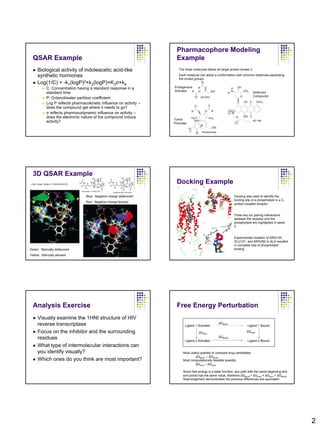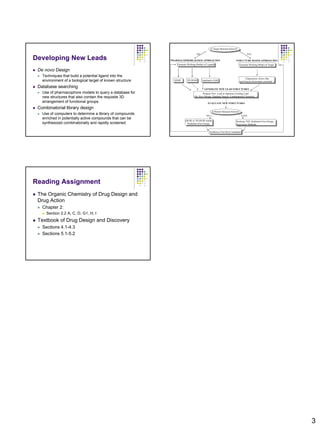Computers overview
- 1. Computer Use in Medicinal Chemistry Overview of Computer- 1. Finding/storing information Aided Drug Design 1. Literature searching (Medline, SciFinderˇ) 2. Structure searching (Protein Databank, SciFinder) 3. Cataloging structure-activity data 2. Modeling existing lead compounds 3. Developing new lead compounds NO Is Target Structure Known? YES Modeling Existing Lead PHARMACOPHORE-BASED APPROACHES STRUCTURE-BASED APPROACHES Compounds Generate Working Models of Ligands Generate Working Model of Target l QSAR l Development of a mathematical model that describes in a predictive manner the relationship between structure (represented by numerical descriptors) and activity Characterize Active Site QSAR 3D QSAR Qualitative SAR (grid-based electrostatic potential...) l Pharmacophore Model Development l Finding a set of functional groups with the same geometric arrangement in a series of compounds with a common biological GENERATE NEW LEAD STRUCTURES activity Propose New Lead or Optimize Existing Lead l 3D QSAR (De Novo Design, Database Search, Combinatorial Chemistry...) l Development of a quantitative model relating structure to biological EVALUATE NEW STRUCTURES activity in which the structural descriptors are values for various properties computed at grid points in three-dimensional space l Docking Is Protein Structure Known? l Development of a model complex of a biological target and a ligand NO YES l Free Energy Perturbation QSAR or 3D QSAR model, Docking, FEP, Hydration Free Energy, l A computational method to determine the differences in free energy Hydration Free Energy... Regression Methods... involved in transferring different ligands from the aqueous solution to a binding site in a biological target Synthesize/Test Best Candidates Group Discussion Group Discussion Points l Questions l Identify some important questions or l QSAR ¨C Can QSAR be used with other identification limitations of technique based on concepts processes? (spectroscopic) l Pharmacophore Modeling ¨C Need to determine from organic chemistry pharmacophore grps in each molecule with similar characteristics Typical chapter titles in organic chemistry textbooks: l Docking ¨C need structures (stereochemistry often not known for initial lead compounds) Structure and bonding; Bonding and molecular properties; Alkanes and cycloalkanes; Stereochemistry; Overview of organic reactions; Alkenes; Alkynes; l Limitations Alkyl halides; Nucleophilic substitutions and eliminations; Structure determination l QSAR ¨C No visual aspect (how to improve activity not (spectroscopy); Conjugated dienes; Benzene and aromaticity; Electrophilic intuitive) aromatic substitution; Alcohols and thiols; Ethers, epoxides and sulfides; Nucleophilic addition to carbonyls; Carboxylic acids; Carboxylic acid derivatives; l Pharmacophore Modeling ¨C Limited to functional groups of Carbonyl alpha-substitution reactions; Carbonyl condensation reactions; similar charge and size Aliphatic amines; Arylamines and phenols; Carbohydrates; Amino acids, l Docking ¨C Does not anticipate potential chemical reactions peptides and proteins; Lipids; Heterocycles and nucleic acids (covalent inhibition) 1
- 2. Pharmacophore Modeling QSAR Example Example l Biological activity of indoleacetic acid-like The three molecules below all target protein kinase C synthetic hormones Each molecule can adopt a conformation with common distances separating the circled groups l Log(1/C) = -k1(logP)2+k2(logP)+K3¦Ň+k4 O l C: Concentration having a standard response in a Endogenous R O H OH Activator R O OH N CH3 standard time R Antitumor O O Compound l P: Octanol/water partition coefficient (S)-DAG O OH O OCH3 l Log P reflects pharmacokinetic influence on activity ¨C O O does the compound get where it needs to go? ¦Ň reflects pharmacodynamic influence on activity ¨C R O O R HO l O does the electronic nature of the compound induce H3C CH3 O OH O Tumor AD 198 activity? Promoter HO O H3 OH C Phorbol Ester O 3D QSAR Example J Mol. Graph. Model. 21 (2003) 263-272 Docking Example Blue: Negative charge disfavored Docking was used to identify the binding site of a phospholipid in a G Red: Negative charge favored protein-coupled receptor Three key ion pairing interactions between the receptor and the phospholipid are highlighted in panel C Experimental mutation of ARG120, GLU121, and ARG292 to ALA resulted in complete loss of phospholipid Green: Sterically disfavored binding Yellow: Sterically allowed Analysis Exercise Free Energy Perturbation l Visually examine the 1HNI structure of HIV reverse transcriptase ?GBind1 Ligand 1 Solvated Ligand 1 Bound l Focus on the inhibitor and the surrounding ?GSolv ?GInter ?GBind2 residues Ligand 2 Solvated Ligand 2 Bound l What type of intermolecular interactions can you identify visually? Most useful quantity to compare drug candidates: ?GBind1 ¨C ?GBind2 l Which ones do you think are most important? Most computationally feasible quantity: ?GSolv ¨C ?GInter Since free energy is a state function, any path with the same beginning and end points has the same value, therefore ?GBind1+ ?GInter = ?GSolv + ?GBind2 Rearrangement demonstrates the previous differences are equivalent 2
- 3. Is Target Structure Known? NO YES Developing New Leads PHARMACOPHORE-BASED APPROACHES STRUCTURE-BASED APPROACHES Generate Working Models of Ligands Generate Working Model of Target l De novo Design l Techniques that build a potential ligand into the Characterize Active Site environment of a biological target of known structure QSAR 3D QSAR Qualitative SAR (grid-based electrostatic potential...) l Database searching GENERATE NEW LEAD STRUCTURES l Use of pharmacophore models to query a database for Propose New Lead or Optimize Existing Lead new structures that also contain the requisite 3D (De Novo Design, Database Search, Combinatorial Chemistry...) arrangement of functional groups EVALUATE NEW STRUCTURES l Combinatorial library design Is Protein Structure Known? l Use of computers to determine a library of compounds NO YES enriched in potentially active compounds that can be QSAR or 3D QSAR model, Docking, FEP, Hydration Free Energy, synthesized combinatorially and rapidly screened Hydration Free Energy... Regression Methods... Synthesize/Test Best Candidates Reading Assignment l The Organic Chemistry of Drug Design and Drug Action l Chapter 2: l Section 2.2 A, C, D, G1, H, I l Textbook of Drug Design and Discovery l Sections 4.1-4.3 l Sections 5.1-5.2 3



